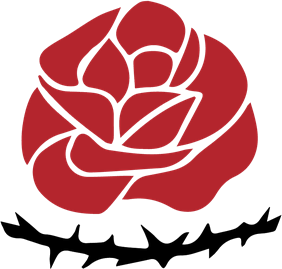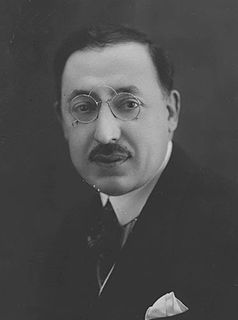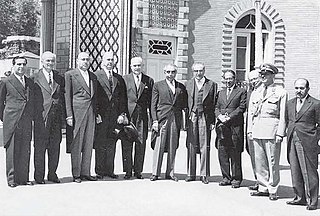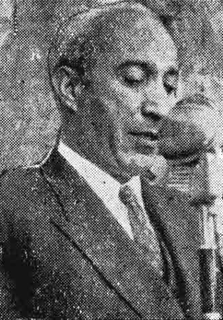
The Tudeh Party of Iran is an Iranian communist party. Formed in 1941, with Soleiman Mirza Eskandari as its head, it had considerable influence in its early years and played an important role during Mohammad Mosaddegh's campaign to nationalize the Anglo-Persian Oil Company and his term as prime minister. The crackdown that followed the 1953 coup against Mosaddegh is said to have "destroyed" the party, although a remnant persisted. The party still exists, but has remained much weaker as a result of its banning in Iran and mass arrests by the Islamic Republic in 1982, as well as the executions of political prisoners in 1988.
Ettehadiyeh-ye Sendika-ye Kargaran-e Iran was a trade union centre in Iran. It was founded on the initiative of the Ministry of Labour and Propaganda in September 1946, with the explicit purpose of competing with the Tudeh-led Central United Council of the Trade Unions of Workers and Toilers of Iran (CUC). The task of setting up ESKI had been delegated to Mehdi Sharif-Emami, the director of the Dispute Settlement Department of the Ministry of Labour and Propaganda. ESKI published the newspaper Kargaran-e Iran. ESKI was a founding member of the International Confederation of Free Trade Unions.
The Central Council of United Trade Unions was a trade union centre in Iran.
The Socialist Party was a leading left-wing political party active in Iran during the 1920s.

Parliamentary elections were held in Iran in 1947. The newly elected parliament was opened on 17 July. The election was a three-way power struggle between Ahmad Qavam, Mohammad Reza Shah and pro-Britain conservative politicians.
The Comrades Party or the Compatriots Party was a left-wing Iranian political party active during the 1940s.

The premiership of Mohammad Mosaddegh began when his first government was formed on 28 April 1951 and ended on 19 August 1953, when his second government was overthrown by the American–British backed coup d'état. During the time, the two cabinets of Mosaddegh took control except for a brief period between 16 and 21 July 1952, in which Ahmad Qavam was the Prime Minister, taking office due to resignation of Mosaddegh from premiership and deposed by Shah after five days of mass demonstrations.
Justice Party was a political party in Iran, led by Ali Dashti who co-founded it with other intellectuals who had participated in the politics of the early 1920s. Other prominent politicians include Jamal Emami, Ebrahim Kajanouri, Farajollah Bahrami, Jamshid Alam and Abulqassem Amini.
Iranian Democrat Party or Democrat Party of Iran was a short-lived political party in Iran, founded in 1946 and led by Ahmad Qavam. It was the most important party formed by the old Qajar nobility, and an association of aristocrats and anti-British radical intellectuals. With the fall of Qavam, it disintegrated in 1948.
The Party of the National Will or National Will Party, formerly named Vatan Party and Halqa Party, was an Anglophile political party in Iran, led by Zia'eddin Tabatabaee. The party played an important role in anti-communist activities, specifically against Tudeh Party of Iran, and was rival to other leftists and civic nationalists who later emerged as the National Front.

The Iran Party is a socialist and nationalist party in Iran, founded in 1941. It is described as the "backbone of the National Front", the leading umbrella organization of Iranian nationalists established in 1949. The party's total membership has never exceeded the several hundred figure.

Socialism inIran or Iranian socialism is a political ideology that traces its beginnings to the 20th century and encompasses various political parties in the country. Iran experienced a short Third World Socialism period at the zenith of the Tudeh Party after the abdication of Reza Shah and his replacement by his son, Mohammad Reza Pahlavi. After failing to reach power, this form of third world socialism was replaced by Mosaddegh's populist, non-aligned Iranian nationalism of the National Front party as the main anti-monarchy force in Iran, reaching power (1949–1953), and it remained with that strength even in opposition until the rise of Islamism and the Iranian Revolution. The Tudehs have moved towards basic socialist communism since then.

Noureddin Alamouti (1901–1965) was an Iranian judge and politician. He served as the justice minister under the cabinet of Ali Amini, during which he was noted for forming a powerful anti-corruption division that led to "the last serious attempt to realize the rule of law" in Pahlavi dynasty.

Fereydoun Keshavarz was an Iranian physician and communist politician.
The Tudeh fraction was the parliamentary group of the Tudeh Party in the Iranian Parliament.

Ahmad Qavam became the Prime Minister of Iran on 27 January 1946, succeeding Ebrahim Hakimi. Qavam who won the competition for office over Hossein Pirnia with 53 to 52 votes, was supported by the Tudeh fraction while deputies associated with the National Will Party voted against him, according to Jamil Hasanli.

Abbas Eskandari was an Iranian Communist politician and a co-founder of Tudeh Party of Iran.

Ali Amini was appointed to rule by decree as the Prime Minister of Iran on 5 May 1961, succeeding Jafar Sharif-Emami. His cabinet was approved on 9 May 1961.

Morteza Yazdi was an Iranian surgeon and communist politician.

Seyyed Ahmad Razavi was an Iranian engineer and politician.











